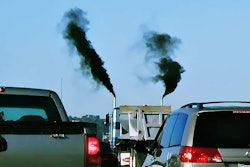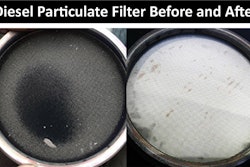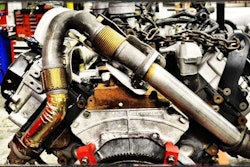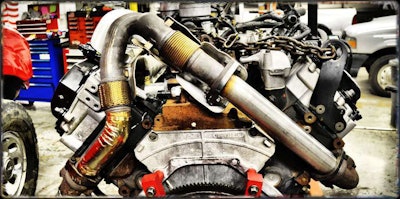
Two federal agencies in June announced criminal charges against five parties, alleging they installed devices to disable emissions control systems — a violation of the Clean Air Act, among other federal laws.
In addition to two-truck owner-operator Dennis Paulhamus of DJ Paulhamus Trucking, one of those charged, regulators brought action against the shop that installed the devices for him, Sweitzer’s Garage. All five pleaded guilty and await sentencing.
The fines they face aren’t pocket change for small businesses. Penalties for truck owners caught tampering with emissions systems are as high as $4,619 per violation. For shops, it’s 10 times that — $46,192 per violation.
Depending on how the U.S. Department of Transportation and the U.S. Environmental Protection Agency tally infractions, Paulhamus could face tens of thousands of dollars in fines. The shop could face hundreds of thousands of dollars in fines, if not more than $1 million.
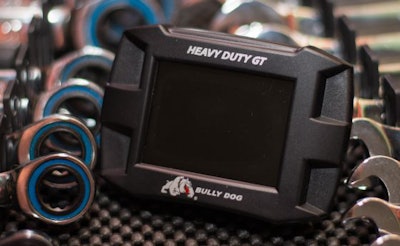 Bully Dog’s HDGT tuner for heavy-duty trucks accesses an engine’s ECM and provides customized tunes, says Katherine French, head of marketing. The company’s light-duty product came under EPA scrutiny this year, resulting in a $6.5 million settlement against Bully Dog’s owner, Derive Systems, though not for improper custom tunes. The problem was a loophole with the tuners that allowed buyers to defeat vehicle emissions controls. Bully Dog’s heavy-duty tuner was not part of the EPA settlement. French says all products sold by the companies today are legal.
Bully Dog’s HDGT tuner for heavy-duty trucks accesses an engine’s ECM and provides customized tunes, says Katherine French, head of marketing. The company’s light-duty product came under EPA scrutiny this year, resulting in a $6.5 million settlement against Bully Dog’s owner, Derive Systems, though not for improper custom tunes. The problem was a loophole with the tuners that allowed buyers to defeat vehicle emissions controls. Bully Dog’s heavy-duty tuner was not part of the EPA settlement. French says all products sold by the companies today are legal.In a separate case in September, the parent company of engine tuner supplier Bully Dog reached a $6.5 million settlement with EPA for selling devices that, intentionally or not, defeated emissions systems. Though Bully Dog’s violations were limited to cars and pickups, these highly publicized crackdowns by EPA and DOT point to a new, and sobering, reality for owner-operators.

In the age of modern emissions control systems, notably exhaust gas recirculation and exhaust aftertreatment, there’s often little that can be done legally or practically to alter engines away from their stock specifications, especially if it means touching emissions control components. Even retuning – a popular modification among owner-operators done by reprogramming an engine’s electronic control module – could put late-model engines out of compliance while putting the owner sideways with EPA.
“You really can’t mess with trucks today,” says Darry Stuart, owner of DWS Fleet Management Services, a longtime maintenance manager and past chairman of the American Trucking Associations’ Technology and Maintenance Council. “You can’t mess with emissions. There are people who creatively think that they can, but it’s purely against the law.”
Just a half-decade ago, engine reprogramming was still a popular option for owner-operators. Tuner suppliers promised stronger horsepower and better fuel economy by reprogramming ECMs to alter fuel injection timing or pressure, or by other methods.
Those tunes often could void warranties and affect engine wear, but they didn’t carry the added risk of heavy fines or legal action from EPA. As more late-model trucks equipped with modern emissions systems have trickled into the secondary market and into the hands of owner-operators, that’s no longer the case.
“It’s absolutely changed,” says Ethan Fortuna, lead electrical engineer for Pittsburgh Power, of what alterations owners and shops can make to late-model engines. Pittsburgh Power is also a Cummins-certified repair facility. “The EPA has quickly made clear that if you’re” tampering with emissions, “there are consequences,” he says.
Engines must remain in compliance with the emissions regulations in effect for their model year. So owner-operators still running older engines, particularly those 2007 and older, are still mostly free to retune and tinker.
Pittsburgh Power is working with EPA and testing a device to allow legal engine tunes of newer engines, says Fortuna. While he sympathizes with owner-operators on the issue, he says the shop is limited in its ability to do much beyond uprating horsepower within manufacturers’ guidelines.
As an exception to the changing engine tuning landscape, Performance Diesel Inc. has developed tunes that are compliant with both EPA regulations and California Air Resources Board regulations, says Jerad Wittwer, the company’s owner. They even have been given stamps of approval by CARB, he says, via executive orders.
The company invested heavily to develop tunes that meet emissions guidelines, yet still increase horsepower and fuel economy, says Wittwer. Still, the tuners don’t uprate the engine outside of the horsepower range specified by the manufacturers for which PDI developed its Big Boss Performance tuner.
He says truck owners should avoid having their engines tuned by companies that haven’t developed compliant options.
Some operators continue to request illegal alterations. Likewise, some shops actively solicit owner-operators, offering them illegal modifications.
“I have to tell them ‘no’ all the time,” says Fortuna of owner-operators asking that the shop tamper with their emissions control systems. Being a Cummins-certified repair shop, “we’re not even allowed to have them on the premises,” he says of engines whose emissions systems have been modified improperly.
One owner-operator interviewed by Overdrive bought a 2012 International ProStar a few years ago as a secondary tractor. It was equipped with a MaxxForce engine, a Navistar line that relied on heavy EGR usage and experienced well-publicized breakdowns.
“Just out of curiosity, I started making phone calls to places” to see what could be done to help ward off MaxxForce issues, says the owner-operator. He declined to speak for attribution due to concern of retribution from the shops he dealt with.
“I was blown away at how bold these places are,” he says. They told him that they would put a plate over the engine’s EGR valve to prevent the recirculation of the exhaust, take off his engine’s diesel particulate filter and reprogram the ECM to defeat the truck’s emissions systems, among other alterations.
Two shops offered such services, he says, and even emailed him estimates that detailed the work.
“I was seriously considering an emissions defeat,” he says, but decided against it after reading of heavy enforcement in such cases.
Shortly after, Navistar announced its own fix, and the operator had the work done at a Navistar dealer. “Even if I have to spend $3,000 a year to replace the EGR valve and the EGR cooler, that’s better than losing my business with a fine,” he says.
Fines aren’t the only pitfall of engine tinkering, says Fortuna. He’s seen disastrous effects of aftermarket modifications on late-model engines. “It’s a terrible idea and a great way to crack a head,” he says of tunes that advance engine timing. “We’ve seen it where the truck only makes it about 10,000 miles before it blows a head gasket or destroys rod bearings.”
Clint Garrett, heavy-duty product manager for Cummins, says engine makers spend large sums developing and validating their engines and emissions control systems that are heavily integrated with the engines. Alterations such as retuning – and especially intentional tampering with emissions systems – can damage engine components, he says.
If an engine is modified illegally, it will be clear to any dealership that works on the engine, Garrett says. “At that point, I’m not sure what our dealership’s response would be, but in a lot of cases, those trucks [can’t] be worked on at our facility,” he says.
Stuart offered an example of a minor modification that he found out is no longer legal. Three years ago, consulting with a fleet, he wanted to turn the engine’s thermostats up to allow them to run slightly hotter to achieve higher fuel economy. “You can’t even do that today, because if you change the thermostat and operating temperature of the vehicle, it will change the [nitrogen oxide] output,” he says.
Engines built between 2010 and 2014 relied more heavily on EGR than do newer engines, says Stuart, making them “challenging to operate cost-wise,” especially as they age. He understands operators’ wishes to mitigate those issues and the higher costs, but he still cautions against it. “It’s not worth it, and it really gives you no gain.”
Stuart foresees a ramp-up in enforcement, if only for EPA to make examples. “There will be somebody that goes to jail for tampering with emissions,” he says. “It’s not going to be me, and that’s the attitude somebody should take. Somebody’s going to get fined — why should it be me?”
Since January 2017, there have been 22 cases settled by EPA involving aftermarket tampering and defeat devices, says agency spokesperson Tricia Lynn. EPA is “actively investigating and addressing aftermarket tampering and defeat device sales” and has “many ongoing and recently resolved enforcement cases” pending, she says.
Fortuna says most cases so far have targeted the shops performing the illegal work. “Typically, they’re not going after owner-operators — yet.”
Buying a modified engine
Should you buy a used truck that’s had its emissions control systems improperly tampered with, you could be on the hook for fines.
But shops are willing to unwind these modifications, says Ethan Fortuna, lead electrical engineer for Pittsburgh Power. “It’s actually something we’ve been doing a bit more of — when they have been tampered with,” he says. Being a Cummins-certified shop, the company is not allowed to have illegally modified engines on its grounds unless it’s for the purpose of repairing the emissions systems.
Clint Garrett, heavy-duty product manager for Cummins, confirmed that certified Cummins facilities “can repair the engine and bring it back into compliance.”
To determine if a truck has been tampered with, truck buyers first should check to make sure the emissions components are in place. “It sounds basic, but that’s the easiest way — just making sure the aftertreatment system is in place and that all the electronic sensors are hooked up,” Garrett says.
If the truck’s “check engine” light is illuminated, operators should pull the codes from the ECM, which could reveal modifications there, he says.




